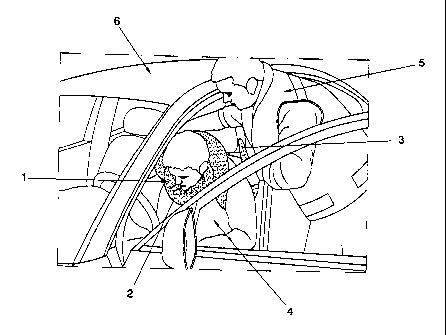Some of the information on this Web page has been provided by external sources. The Government of Canada is not responsible for the accuracy, reliability or currency of the information supplied by external sources. Users wishing to rely upon this information should consult directly with the source of the information. Content provided by external sources is not subject to official languages, privacy and accessibility requirements.
Any discrepancies in the text and image of the Claims and Abstract are due to differing posting times. Text of the Claims and Abstract are posted:
| (12) Patent: | (11) CA 2718461 |
|---|---|
| (54) English Title: | DEVICE FOR REMOVING PEOPLE IN A LIFE-THREATENING SITUATION AND METHOD FOR USE |
| (54) French Title: | DISPOSITIF PERMETTANT L'EXTRACTION DE PERSONNES EN CAS D'URGENCE VITALE ET PROCEDE D'UTILISATION CORRESPONDANT |
| Status: | Granted and Issued |
| (51) International Patent Classification (IPC): |
|
|---|---|
| (72) Inventors : |
|
| (73) Owners : |
|
| (71) Applicants : |
|
| (74) Agent: | MARKS & CLERK |
| (74) Associate agent: | |
| (45) Issued: | 2015-10-20 |
| (86) PCT Filing Date: | 2008-05-22 |
| (87) Open to Public Inspection: | 2009-09-17 |
| Examination requested: | 2013-04-16 |
| Availability of licence: | N/A |
| Dedicated to the Public: | N/A |
| (25) Language of filing: | English |
| Patent Cooperation Treaty (PCT): | Yes |
|---|---|
| (86) PCT Filing Number: | PCT/ES2008/000359 |
| (87) International Publication Number: | WO 2009112599 |
| (85) National Entry: | 2010-09-13 |
| (30) Application Priority Data: | ||||||
|---|---|---|---|---|---|---|
|
The device comprises an elongate, soft, flexible body (1) provided with a
central zone (2) that is thicker than two tapered ends (3). The method
involves
passing said central zone (2) around an accident victim's neck, crossing the
tapered ends (3) over the nape of the neck and arranging same under the
armpits, from front to back, such that said ends project behind the accident
victim and a rescuer can pull thereon in order to move the accident victim
whilst
the latter's neck is immobilized.
L'invention concerne un dispositif comprenant un corps allongé matelassé et souple (1) pourvu d'une zone centrale (2) présentant un volume plus important que deux extrémités plus fines (3). Selon le procédé décrit dans cette invention, la zone centrale (2) est placée autour du cou d'une personne accidentée, puis elle est croisée au niveau de la nuque, les deux extrémités plus fines (3) étant placées sur la partie avant des aisselles, de telle sorte que lesdites extrémités soient en saillie derrière la personne accidentée et qu'un secouriste puisse les saisir afin de déplacer la personne accidentée en garantissant une immobilisation de son cou.
Note: Claims are shown in the official language in which they were submitted.
Note: Descriptions are shown in the official language in which they were submitted.

2024-08-01:As part of the Next Generation Patents (NGP) transition, the Canadian Patents Database (CPD) now contains a more detailed Event History, which replicates the Event Log of our new back-office solution.
Please note that "Inactive:" events refers to events no longer in use in our new back-office solution.
For a clearer understanding of the status of the application/patent presented on this page, the site Disclaimer , as well as the definitions for Patent , Event History , Maintenance Fee and Payment History should be consulted.
| Description | Date |
|---|---|
| Letter Sent | 2024-05-22 |
| Maintenance Fee Payment Determined Compliant | 2023-10-13 |
| Inactive: Late MF processed | 2023-10-13 |
| Letter Sent | 2023-05-23 |
| Common Representative Appointed | 2019-10-30 |
| Common Representative Appointed | 2019-10-30 |
| Inactive: Late MF processed | 2019-10-10 |
| Change of Address or Method of Correspondence Request Received | 2019-07-24 |
| Letter Sent | 2019-05-22 |
| Grant by Issuance | 2015-10-20 |
| Inactive: Cover page published | 2015-10-19 |
| Pre-grant | 2015-06-30 |
| Inactive: Final fee received | 2015-06-30 |
| Notice of Allowance is Issued | 2015-06-05 |
| Letter Sent | 2015-06-05 |
| Notice of Allowance is Issued | 2015-06-05 |
| Inactive: Q2 passed | 2015-05-11 |
| Inactive: Approved for allowance (AFA) | 2015-05-11 |
| Amendment Received - Voluntary Amendment | 2015-04-30 |
| Inactive: S.30(2) Rules - Examiner requisition | 2015-04-02 |
| Inactive: Report - No QC | 2015-03-26 |
| Amendment Received - Voluntary Amendment | 2015-02-18 |
| Inactive: S.30(2) Rules - Examiner requisition | 2014-11-27 |
| Inactive: Report - No QC | 2014-11-05 |
| Amendment Received - Voluntary Amendment | 2014-09-26 |
| Inactive: S.30(2) Rules - Examiner requisition | 2014-03-28 |
| Inactive: Report - No QC | 2014-03-19 |
| Letter Sent | 2013-04-24 |
| Request for Examination Received | 2013-04-16 |
| Request for Examination Requirements Determined Compliant | 2013-04-16 |
| All Requirements for Examination Determined Compliant | 2013-04-16 |
| Inactive: Cover page published | 2010-12-16 |
| Inactive: First IPC assigned | 2010-11-12 |
| Inactive: Notice - National entry - No RFE | 2010-11-12 |
| Inactive: Inventor deleted | 2010-11-12 |
| Inactive: IPC assigned | 2010-11-12 |
| Application Received - PCT | 2010-11-12 |
| National Entry Requirements Determined Compliant | 2010-09-13 |
| Application Published (Open to Public Inspection) | 2009-09-17 |
There is no abandonment history.
The last payment was received on 2015-05-19
Note : If the full payment has not been received on or before the date indicated, a further fee may be required which may be one of the following
Please refer to the CIPO Patent Fees web page to see all current fee amounts.
Note: Records showing the ownership history in alphabetical order.
| Current Owners on Record |
|---|
| FRANCISCO JAVIER GIL VIZUETE |
| Past Owners on Record |
|---|
| None |